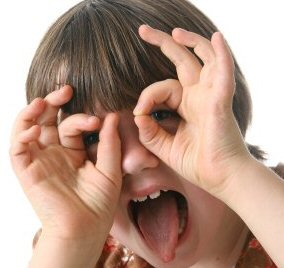Tips on How to Manage Your Hyperactive Child
 John is eight years old. He is an inattentive, impulsive and hyperactive
child who is facing serious academic, social and disciplinary problems. He often
fails to finish things he starts, doesn't seem to listen and is easily
distracted. Because of poor concentration, he often makes mistakes, loses books,
pens and pencils. He finds it difficult to sit in one place for long and is
fidgety. He keeps switching activities or running around and needs constant
supervision. John is eight years old. He is an inattentive, impulsive and hyperactive
child who is facing serious academic, social and disciplinary problems. He often
fails to finish things he starts, doesn't seem to listen and is easily
distracted. Because of poor concentration, he often makes mistakes, loses books,
pens and pencils. He finds it difficult to sit in one place for long and is
fidgety. He keeps switching activities or running around and needs constant
supervision.
John is suffering from Attention Deficit/Hyperactivity Disorder (ADHD), which
accounts for the largest category of psychological referrals among children.
This disorder affects about 5% of primary schoolchildren, with 75% or more being
boys. The exact cause of ADHD is not known, but it seems to be a genetic
disorder. There is presumptive evidence of minimal brain damage, which in most
cases is genetically inherited, but ADHD could also be due to complications
during pregnancy and birth. A history of learning or conduct problems is
commonly found in a parent or close relative of children with ADHD. Early
identification and prompt intervention is crucial for these children, as it can
prevent maladjustment at home and with the peer group. Although principles of
management are useful, individualized care for each child achieves greater
success. Effective treatment depends on close co-operation and constant
communication between the psychotherapist, parents and school. This helps to
reduce frustration and feelings of helplessness in the child, as well as the
care providers.
Below you'll find some tips on how to manage your hyperactive child.
Encourage Good Behavior Immediately

When a hyperactive child acts or behaves impulsively or in a socially
unacceptable manner, don't just point out his/her mistake, but try to explain
the inappropriateness of his/her behavior. Encourage good behavior immediately
by praise or gift because waiting too long to reward the child may not have the
desired effect.
Try To Identify Strengths of Child
Parents and teachers should try to identify those strengths of their child which
can be praised in public. This not only boosts the child's morale, but also
changes the negative mindset of other children.
 Use Alarm Clock Use Alarm Clock
At home, an alarm clock can be used to deal with the problem. Make a deal with
the child – he/she can get up only after the alarm goes off. Set the alarm for
30 minutes in the beginning and subsequently increase it to 45 minutes and then
an hour. The anticipation of being allowed to leave the seat motivates the child
to remain seated. This conditioning exercise has been successful with most
children and should help your child too.
Establish Close Cooperation with Teachers

Hyperactive children are generally disorganized and frequently forget to write
down homework assignments. They also have problems in listening and taking
notes. Parents must establish close cooperation with teachers and request them
to spare a few minutes to verify whether the child has completed his/her
class-work and taken down the home assignment or not. Occasionally, the teacher
may allow the child some extra time to complete his/her work. Parents can also
seek the help of a friend and ask his/her to assist their child with his/her
work.
Designate the Study Area
Do not allow the child to study just anywhere in the house. To prevent
distraction and improve concentration, switch off the lights in the room and use
a table lamp. Treating the study area as sacred (by removing one's slippers,
lighting incense, etc.) may help in motivating the child.
Avoid Giving Multiple Tasks
Avoid giving multiple instructions or assignments simultaneously. Allow the
child to carry out one direction or finish one assignment, before going on to
the next one. Some children get flustered if there's too much to do. The way out
is to allow the child to tackle one problem at a time and keep the rest covered
by a piece of paper.
Permit the Child to Use Graph Paper
 Permitting the child to use graph paper while doing arithmetic work provides a
structured format to place numbers. Large graph paper should be used so that the
child can easily place one number in each box. This helps the child to approach
the task in a systematic manner. There is no harm in allowing these children to
use a calculator. They should also be provided with basic maths tables and
formulas while doing their assignments. The aim here is to successfully
accomplish the task at hand by avoiding frustration arising from the inability
to remember and recall the facts. Permitting the child to use graph paper while doing arithmetic work provides a
structured format to place numbers. Large graph paper should be used so that the
child can easily place one number in each box. This helps the child to approach
the task in a systematic manner. There is no harm in allowing these children to
use a calculator. They should also be provided with basic maths tables and
formulas while doing their assignments. The aim here is to successfully
accomplish the task at hand by avoiding frustration arising from the inability
to remember and recall the facts.
Tape-Record a Chapter
Some children grasp concepts better if they are provided with auditory and
visual inputs concomitantly. Parents can record a chapter so that the child can
read and listen at the same time.
Use a Computer to Organize Your Child's Work
The computer has become popular in most households, and the child should be
familiarized with it at the earliest. A computer can be used to organize your
child's work, to teach typing skills, and to improve his/her vocabulary by using
various educational programs. This machine is fascinating, addicting, and can be
motivating. The child will feel very good about himself/herself, especially when
they see positive grades generated by his/her own efforts.
Organize Your Child's Things at Night
Organize your child's things at night to avoid stress and confusion before going
to school in the morning. Ask the child to keep a checklist, so that the school
dress, books, copies and home assignment are ready for the next morning. This
will help the child feel secure as he/she will get to school better prepared.
Be Realistic About Your Expectations from the Child
Parents must be realistic about their expectations from the child and
should ignore minor incidents and focus on the major areas of concern. They
should familiarize themselves with the situations which frustrate the child.
Avoiding confrontation and providing emotional support is the right approach
during such moments.
Psychotherapy
Psychotherapy helps the child to:
- Gain self-esteem
- Release pent up frustration
- Acquire control over impulsiveness
Psychotherapists use “behavior modification” to control hyperactivity and
improve the child's power to concentrate. This mode of treatment involves a
system of incentives and deterrents, daily report cards, and feedback sessions.
Some people also recommend family therapy.
Medication

There has been a lot of research on the use of medication for the treatment of
ADHD. Methylphenidate, Atomoxetine and Imipramine are used in the treatment of
ADHD. These drugs are highly effective and very safe.
Methylphenidate: This is a first-line drug used in the treatment of
ADHD. It is a psycho stimulant and produces significant improvement in attention
span, impulse control, hyperactivity and aggressive behavior. This results in
better organization of behavior, task completion and self-regulation. The
child's social skills and academic performance improve considerably.
Methylphenidate is available as 10 mg scored (can be broken into two equal
parts) tablets. The dose range is 10-60 mg/day. The usual starting dose is 5 mg;
the dose is then gradually increased by 5 mg intervals to a maximum of 60
mg/day. Most children will need to take it three times a day (8 am, 12 pm and 4
pm). This schedule gives cover during school hours and during homework time. It
provides an opportunity for children to interact with teachers, peers and
parents while experiencing the beneficial effects of the medication.
The most common side effects of methylphenidate are abdominal pain, decreased
appetite, headache and insomnia (during the first few days). The heart rate and
blood pressure may show a slight increase. Some children experience irritability
and sudden mood changes. Earlier it was thought that methylphenidate inhibits
the production of growth hormone and “holidays” from the drug were recommended
so that the body could catch-up with this deficiency. The current medical view
is that methylphenidate does not decrease the production of growth hormone and
has no adverse effect on a child's growth. Therefore, drug “holidays” are not
necessary and the medication can be used whenever it is needed.
Atomoxetine: This is also a first-line drug which is very effective in
the management of ADHD. It has been studied extensively in children with this
disorder, and has been shown to reduce both inattentive and
hyperactive/impulsive symptoms. Atomoxetine can be administered on either a
twice-daily or once-daily schedule. The usual starting dose is 40 mg/day. It can
be increased to 100 mg/day.
Adverse effects of Atomoxetine are generally mild, with sedation, nausea,
abdominal pain and vomiting being most common. Because its effects are highly
selective, it is believed to have no abuse potential. This is one major
advantage it has over Methylphenidate. Another advantage over Methylphenidate is
that Atomoxetine is widely and freely available because there are no
restrictions on its stocking, prescription and dispensing.
Imipramine: This is a second-line drug used in the treatment of ADHD. The
usual dose is 10-20 mg/day. It is available as 10 and 20 mg tablets and is also
known as Depsonil, Antidep and Depsol. Imipramine is also used in the treatment
of depression and enuresis (bed-wetting).
Parenting
Silent Bully: What Every Parent and Child Should Know
How to Protect Your Children Against Online Dangers
The Most Common Problems Teenagers Face Today
Tips on How to Manage Your Hyperactive Child
How to Make Your Child Into a Leader
Parenting Children with Learning Disabilities
10 Tips to Communicate Better with Your Child
How to Encourage Confidence in Your Child |